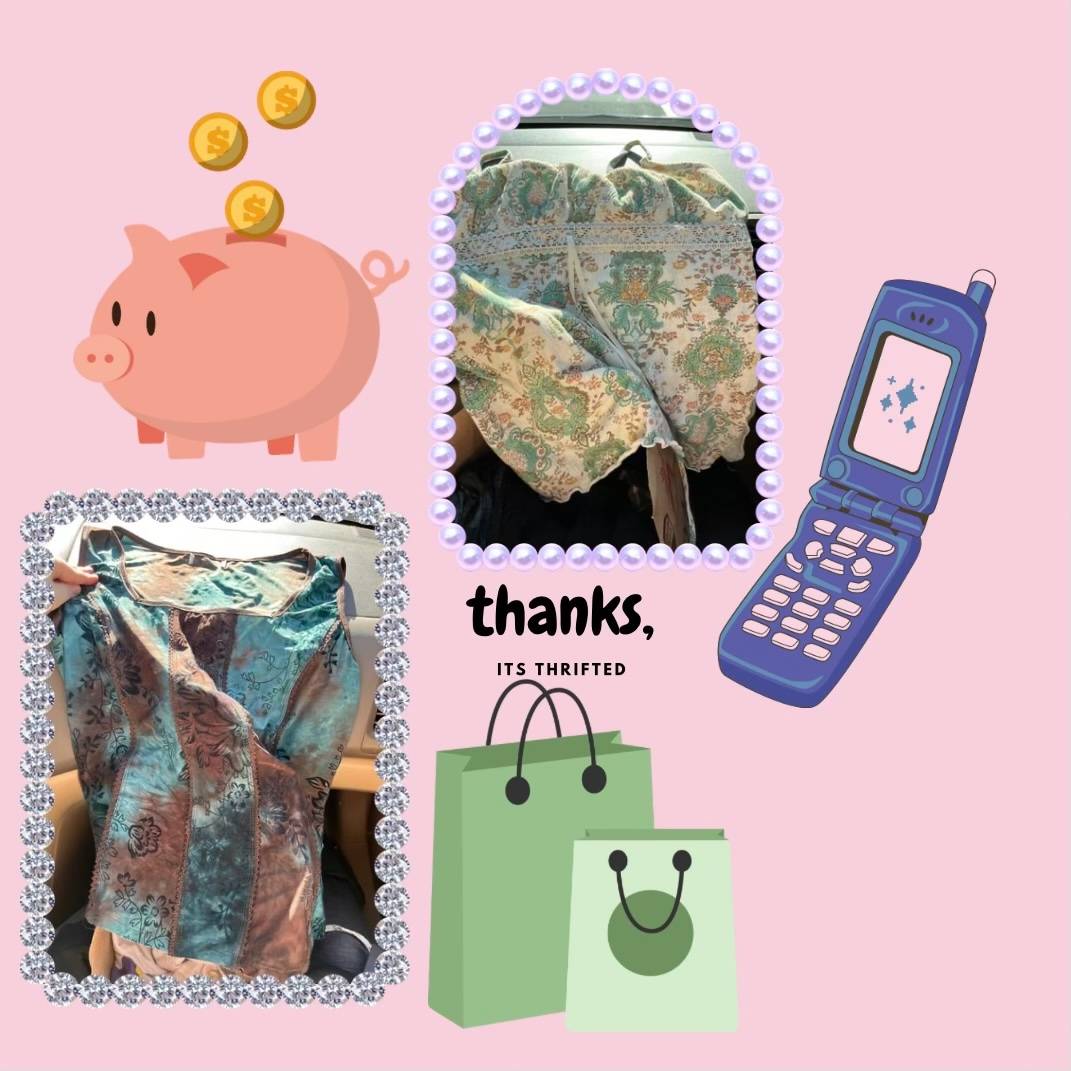Blog
Permanent link for Let's Get Thrifty: April Shower Savings on April 5, 2024
As college students, many of us find ourselves trying our best to stick to a budget while also enjoying our college experience. There is a ton of financial advice out there about budgeting, lowering our living expenses, and how to find financial resources. However, we of course still want to have fun and wear the clothes we like and decorate our dorms or apartments the way we want. Here’s a secret: you can still have fun and express your style while shopping second-hand. Let's dive into how.
Shopping second-hand is one of the most effective ways to stay in or even under budget when it comes to clothing, furniture, and homewares. There are tons of thrift stores and second-hand shops that offer high-quality items at lower prices. Personally, I grew up lower-income and have been shopping second-hand my whole life. However, I acknowledge that there might be some stigma attached to it. If you're uncertain about diving into second-hand shopping, let's weigh the pros and cons.
Pros:
- Affordability: Items are often priced lower than their original retail price, making it budget-friendly.
- Unique Finds: You can discover one-of-a-kind pieces.
- Quality: Vintage items may be of higher quality than many modern counterparts, as they have stood the test of time.
- Sustainability: Extending the lifespan of clothing reduces waste and lessens the environmental impact of fast fashion.
- Supporting Small Businesses: Many vintage and secondhand shops are locally owned, providing the opportunity to support small businesses and local economies.
- Treasure Hunting: There's a thrill in the hunt for hidden gems and unique treasures.
Cons:
- Limited Sizing: Finding items in specific sizes can be challenging, especially for folks that wear non-standard sizing.
- Condition Concerns: Some items may show signs of wear or damage, requiring repairs or alterations.
- Time-Consuming: It may take time to sift through racks or online listings to find the perfect piece.
- Lack of Returns: Many second-hand stores have strict no-return policies, so you need to be sure about your purchases.
- Availability: Desired items may not always be in stock, especially for popular or sought-after pieces.
- Limited Selection: Depending on the location or store, the selection of items may be limited, leading to fewer choices.
When it comes to second-hand shopping, it's essential to understand the different types of stores and shopping methods available.
Thrift stores:
- Often donation-based, offering affordable prices ranging from $1 to $5 per item.
- Examples include
Consignment shops:
- Typically carry currently in-style and on-trend items, priced mid to high range, around $5 to $15 per item.
- Examples include
- Uptown Cheapskate- Grandville
- Style Encore - Grandville
- Plato's Closet- Grandville
- Urban Exchange- Grand Rapids
- Rock Paper Scissors Consignment Boutique- Grand Rapids
Vintage/antique shops:
- Offer items priced on the higher end, with pricing varying based on factors such as rarity and condition.
- Examples include:
- Le Vintage Rose Retro Shoppe- Grandville
- Decaydence Vintage- Grand Rapids (no website)
In addition to physical stores, there are other avenues for second-hand shopping, including online platforms like Facebook Marketplace and Buy Nothing Facebook Groups. You can also organize clothing swaps with friends or utilize resources like the CWGE’s Replenish Basic Needs Center for essential items.
So, how can you navigate second-hand shopping effectively? Here are some tips:
- Know What You Want: Have a clear idea of what you're looking for before you start shopping. This can help you stay focused and avoid impulse buys.
- Check for Quality: Inspect items carefully for signs of wear, damage, or stains. Pay attention to seams, buttons, zippers, and overall construction.
- Try Things On: Since sizes can vary widely in second-hand clothing, it's essential to try items on whenever possible to ensure a proper fit.
- Be Open-Minded: Keep an open mind and be willing to try new styles or brands. You might discover hidden gems that you wouldn't have considered otherwise.
- Research Brands: Familiarize yourself with brands known for their quality and durability.
- Shop Off-Peak Hours: Visit thrift stores during weekdays or early mornings when they're less crowded. This can give you more time and space to browse without feeling rushed.
- Set a Budget: Decide how much you're willing to spend before you start shopping. Setting a budget can help prevent overspending and ensure that you stick to your financial goals.
- Look for Sales and Discounts: Many thrift stores offer sales or
discounts on certain days of the week. Take advantage of these deals
to maximize your savings.
- Pro tip: ask if they have a student discount!
- Consider Alterations: Don't dismiss an item just because it doesn't fit perfectly. With a little bit of tailoring, you can often transform a thrifted find into a custom piece that's uniquely yours. Learning the basics of sewing can be really helpful- and often, you can find a sewing kit second-hand, too!
With these tips in mind, you can make the most out of your second-hand shopping experience, saving money while expressing your style and reducing your environmental footprint.
By: Rowan, WIT Peer Educator
Categories:
General Wellness
Posted
on
Permanent link for Let's Get Thrifty: April Shower Savings on April 5, 2024.

